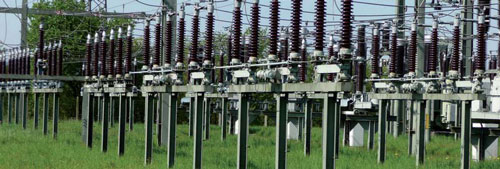Transformers and transformer oils
A transformer consists in principle of a magnetic circuit, an iron core around which the conductors of at least two adjacent circuits in coils are wound, usually with different numbers of turns.
As a rule, copper wire is used for the windings. The winding on the line side is termed the primary side. The winding supplying the electrical load is termed the secondary side. An alternating voltage induces a varying magnetic field in the input winding and an induction voltage in the output winding. The size of this voltage depends on the winding ratio of the primary and secondary side of the transformer. If the number of turns on the primary side is greater than that on the secondary side, then the output voltage is less than the input voltage. This also applies conversely.
In order to insulate the live parts, the copper wires are varnished with synthetic resin or wrapped in fi lms or special papers. Supplementary protection against a sudden discharge is provided by specially designed transformer oils. These insulating oils based on mineral oils, esters or silicon must insulate, cool, be stable at low temperatures and resistant to oxidation and blend with winding and insulation materials.
Table of contents
Insulating properties
Transformer oils insulate the high potential differences, impregnate fibrous insulating materials and contribute to preventing any electric arcs. As a dielectric, they prevent discharges between the live elements at voltages of up to 100 kV. The voltage up to which no discharge of sparks occurs under precisely defi ned conditions is termed the breakdown voltage. The breakdown voltage of a transformer, but also of the oil, must be significantly higher than its nominal voltage. This is by far the most important parameter for the electrical insulating property of the oil. Traces of water, which is a good electrical conductor, have a negative impact on the useful life of the system. Fresh oils are thus dried during production with vacuum thin film vaporisers. These oils are delivered in containers under a nitrogen blanket in order to prevent penetration of humidity. Transformer oils also expand at high temperatures and contract at low temperatures. For 1,000 litres of oil and a temperature difference of 50°C, this amounts to 35 litres. Transformers thus have an expansion reservoir. Depending on the type of construction, this is provided with dry cartouches, which extract humidity from the air. In determining the further serviceability of transformer oils, the breakdown voltage and the water content are decisive criteria.

Cooling effect
The coils of a transformer consist of closely wound wires. Heat is generated in the interior of these windings, which is conducted away by the oil. In order to dissipate heat into the surrounding area, large surfaces are required. For this reason, transformers mostly look like enormous radiators, which are sometimes equipped with additional ventilators or heat exchangers. In order for the oil to circulate properly, these must be correspondingly thin. The measurement of viscosities, which can increase from the usual 8-9 mm²/s at 40°C to over 10 mm²/s due to operating influences, is an integral part of every trend analysis.
Oxidation stability
Transformer oils should remain in use for decades. High oxidation stability is thus particularly important. Depending on the working temperature, the oil oxidation increases, which in turn shortens the useful life of the oil filling and makes the oil „sour“ and darker. The viscosity also increases and conductivity decreases. In addition, water from humidity or decomposition products from the insulation paper change the dielectric strength. For this reason, the performance of these oils must be constantly rechecked. Within the context of a trend analysis, the colour index and acid value are measured and the oxygen incorporated by the oil due to ageing determined with the FT-IR device.
Compatibility
Transformer oils must be compatible with all of the materials with which they come into direct contact. This includes copper, since it is used in the windings, resin, special winding papers and other insulating materials and seals.
Oil types and specifications
Depending on the particular system, different types of transformer oils are used:
Synthetic transformer oils
- Silicon oils
- Synthetic esters
For selection, it is imperative to observe the manufacturer‘ s specifi cations. Products must often meet the specifications of institutions, such as:
- Verband der Elektrotechnik Elektronik Informationstechnik e.V. (VDE)
- International Electrotechnical Commission (IEC
- American Society for Testing and Materials (ASTM)
Read also: The OELCHECK analytical sets for transformer oils
Mineral oil-based transformer oils
- Classic transformer oils without additives
- Inhibited oils, e.g. with good oxidation stability
ÖlChecker Winter 2011, page 5



